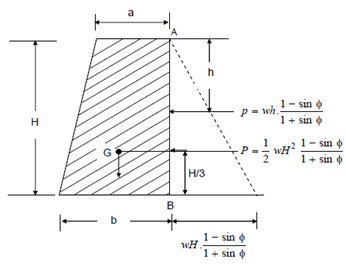Pressures on Retaining Walls Due To Granular Materials - Rankine's Theory:
Earth material (or any other granular material like sand, cement grains, etc.) when collected in a heap tends to adopt a slope, that is characteristics of the material and is known as its "angle of repose". This is because of the internal friction between the grains of the material. The French engineer, Rankine, developed the theory of earth pressures within the 18th century.
A Rankine's earth pressure equation gives the horizontal earth pressure on the vertical face of a retaining wall due to a level earth fill behind if the earth pressure (p) can be expressed as
p = wh 1 - sin φ/1 + sin φ = kwh
where k = 1 - sin φ/1 + sin φ is the Rankine's earth pressure coefficient,
w = Unit weight of the material,
h = Depth of the point at which pressure is sought, and
φ = Angle of internal friction (or angle of repose) of the material.
This is shown in Figure where the maximum pressure on the vertical face of the retaining wall AB at depth H is
p = wH (1 - sin φ/1 + sin φ)
and the pressure diagram is a triangle. A total pressure is the area of the triangle and is given as
P = (1/2) wH2 1 - sin φ/1 + sin φ
and acts at a depth H/3 from the bottom

Figure